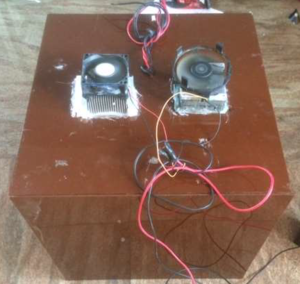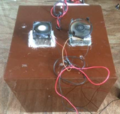
Nearly two-thirds of the energy that is produced by conventional power generation methods is lost as heat. Be it in thermal power plants, nuclear power plants or something as common as a car, that we use everyday. By harnessing this heat, we increase the overall efficiency of the system, hence, reducing the carbon emission, and potentially saving huge amounts of money. Thermoelectric materials like bismuth and lead tellurides show high Seebeck coefficients, which essentially means that the amount of power generated per unit change in temperature is higher. This, along with high electrical conductivity and low electrical conductivity are the traits expected in a thermoelectric material. Historically, these materials have been used in Cassini and Voyager space missions.
Project Goals
Thermoelectricity is yet to be used on a large scale. The goal of the project was to build inexpensive thermoelectric modules to be in used in small, easy-to-make, and portable cooling machines.[1]
Design
The first step was to synthesise a good thermoelectric material. We chose to make polymer composites as is much cheaper than using bulk thermoelectric materials. Polymerised pyrrole (a conducting polymer) was used as the matrix, and it was reinforced with vanadium oxide nanobelts. Both were synthesised in the lab and pellets were made out of the resulting composite. These pellets were individually stacked in an appropriate fashion to create a thermoelectric module.
We built a small cooling machine out of scrapped metal sheets and thermal insulators. The thermoelectric module was coupled with exchangers and a heat sink and installed into the box through incisions. What this effectively does, is absorb the heat and covert it into electricity through the thermoelectric module, and use this electricity to run the assembled cooler.
- Design Process
-
Vanadium oxide nanobelts SEM image
-
Making the thermoelectric module
-
Making the Cooler, step-1
-
Making the Cooler, step-2
-
Making the Cooler, step-3
-
Final Design
Costs
Costs involved in making the thermoelectric module and cooler:
| Expenditure | TE Module | Cooler | Total |
|---|---|---|---|
| Raw Materials | $45 | $10 | $55 |
| Synthesis | $30 | $10 | $40 |
Grand total = $95
Discussion
Although the efficiency of the system is low (<4%) due to the repeated conversion of the form energy, it is to be noted that no external source is used. Additionally, these coolers operate without any refrigerants.
Next steps
Naturally, the next step is to increase the efficiency. This is as much a materials science challenge as it is an engineering challenge, as the efficiency of bulk thermoelectric materials it self is <6%. Hence, we plan to research on more inexpensive materials that show good Seebeck coefficient.
Another goal that we would like to pursue is the integration of thermoelectricity with photovoltaics, as they would boost efficiency overall when they're working in tandem.
Conclusions
Thermoelectric materials, like solar cells, convert electricity directly without any moving parts, which is suitable for a static system. Hence finding an optimised material that exhibits good characteristics of both photovolaics and thermoelectricity is something that would benefit humanity greatly.
References
- B.V. Chaluvaraju, K. Sangappa, M.V. Ganiger, Murugendrappa,
Polym. Sci. 57(4), 467–472 (2015)
Contact details
E-mail: prajwal.ml714@gmail.com
- ↑ You can use the ref code to include inline references. See Help:Footnotes for more.





